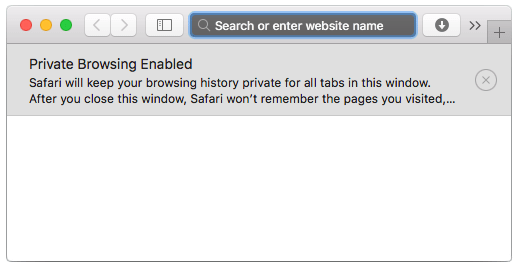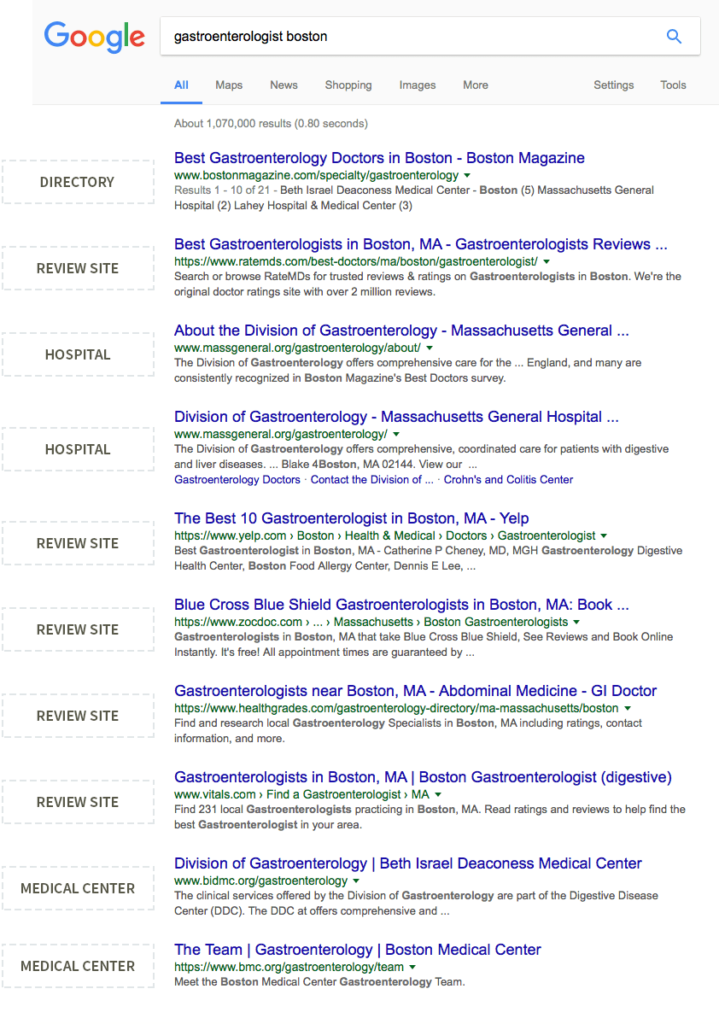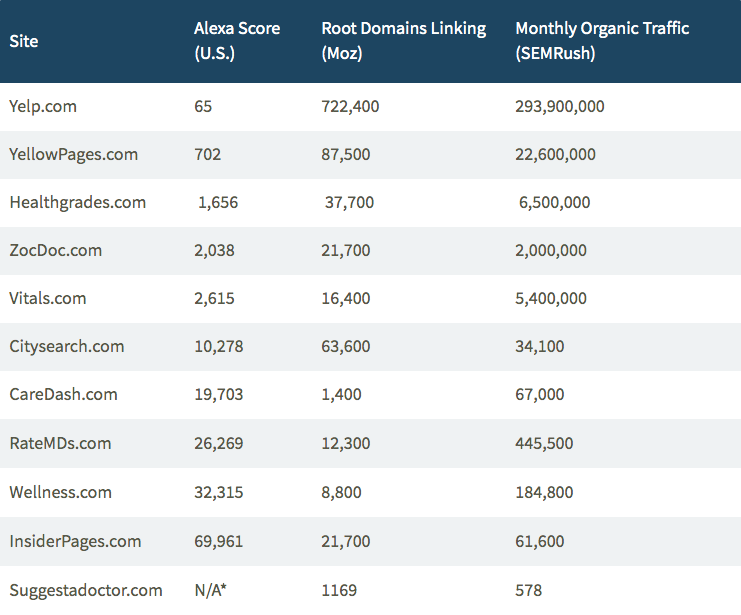A guide to what patients see when they search Google for medical practices and physicians.
We’ve worked with hundreds of practices across the country, providing websites and online marketing services via our P3 platform.
Although every practice is different and has different needs, we often get questions like, “Why isn’t my website showing up in Google?” or “How do I get my website listed on the first page of Google?”
Often, the answer to that question isn’t so simple. There are several factors that play into Google ranking, and Google isn’t completely forthcoming on exactly how they rank websites in search results.
While we can’t give a definitive answer on what practices need to do to get their websites on the first page of Google search results, we wanted to identify common factors among top-ranking practice websites. No one can guarantee a spot on the first page of Google results (and we strongly suggest you run from any marketing company that does promise that), but by studying the top sites currently in search results, we can start to identify common patterns.
Save this report for later. Download a copy!
Background
Before we dive into our findings, we want to provide some detail on how we approached this project. Search engine results are constantly changing, and this is something that we encourage you to try on your own as you devise an online marketing strategy for your practice.
To compile this information, we reviewed the search engine results pages in the top 10 U.S. markets for physicians in the following specialties: orthopedics, gastroenterology, podiatry, cardiology, urology, dermatology, dentistry, and plastic surgery.
After finding our top 10 U.S. markets, we identified our keywords. For consistency, we wanted to keep the keyword format as close as possible, so we used the format “type of specialist+city.” For example when searching for an orthopedic surgeon in Los Angeles, we used the keyword “orthopedic surgeon los angeles.”

Next, we conducted our searches. We used the incognito mode on our browsers to conduct these searches, because your browser does not save your browsing history while incognito mode. This is helpful for this type of search, because your prior search and browsing history can affect the search engine results you see in the normal browsing mode. With incognito mode, you essentially have a clean slate and are able to get a more accurate sense of that actually shows up in search results for a particular keyword.
Now, let’s get into the results.
Our Findings
After reviewing several pages of search results, we were able to point out a few common factors in search results across all specialties.
The one caveat to this information is that results for plastic surgeons in all markets were very different from the results for all other specialties, and therefore were excluded from these results. Plastic surgery results were primarily comprised of single-physician practices, almost no hospital results, and very few review and directory sites. The field of plastic surgery is very different from the other types of specialties we reviewed, and plastic surgery practices approach marketing in different ways than other healthcare practices do. For that reason, we felt it was best not to compare those results with the other specialties, which on the whole were very similar.
Now, without further ado, these are the 4 common elements we found in search results across all of the specialties and markets we reviewed.
1. Results were a mix of medical practice websites, hospitals/health systems, and review/directory sites.
The search results for the specialties we investigated all had a diverse mix of options. Medical practice websites were, of course, included in the results, but there were other options as well. Hospitals and large healthcare groups also showed up in search results if they offered services within a particular specialty. In most cases, the page for that particular department would be the page that showed up in search results.
Review and directory sites were also very common in search results for each specialty and market. Review sites are the sites that allow patients to review their physicians, including Healthgrades, RateMDs, Yelp, and Vitals. These sites will then compile lists of specialists within a particular location, and those lists show up in search results.
Directory sites are similar to review sites in that they provide lists of doctors within a particular specialty and location. However, they do not provide user-submitted patient reviews. Examples of these sites can include national sites like Super Doctors and U.S. News Health Care, or local websites like Washingtonian (in Washington, DC) and Boston Magazine (in Boston, MA).
Below is what the first page of organic results look like for the search query “gastroenterologist boston”.

All of this means that practices are competing with more than just other practices to get onto the first page of search results. They also have to contend with hospitals, large healthcare groups, review sites, and local directories.
2. Hospitals and larger medical practices tend to show up in search results more frequently than smaller, independent practices.
Overall, there were more hospital and large group practices (with 5 or more physicians) in search results than small, independent practices. Perhaps these larger practices have strength in numbers, and it is more difficult for a single physician or even a few physicians to compete with several physicians at once.
It also may have to do with the fact that the healthcare industry as a whole is trending toward larger practices. In 2016, Becker’s Hospital Review reported that the majority of physicians are turning toward employment with larger practices and hospitals. It was projected that the number of physicians in private practice would drop to 33% by the end of 2016. With more and more physicians stepping away from private practice, there may simply be fewer private practices available to compete.
However, we did still see private practices show up in search results, so ranking in search results is still attainable for smaller practices.
Below is an example of what the first page of organic results looks like for the search query “orthopedic surgeon houston”. Two independent practices showed up in search results, with one showing up twice. In smaller markets, there were higher instances of practice websites in search results.

3. On average, review sites and directories take up about half of the spots on the first page of organic search results.
Not including paid search and map listings, Google displays 10 organic search results per page. On average, we saw 4-5 review site and directory listings in search results for every specialty and market we looked at. With the prevalence of these type of sites in search results, that only leaves about 5-6 spots (and even fewer spots in some markets) for hospitals, health systems, and medical practices.
With fewer spots available on the first page of search results, practices will need to work even harder on their online marketing to obtain one of the coveted first-page spots. Simply having a website is not going to cut it in most markets–practices need to focus on content and modernizing their websites to rank in more competitive markets (more on that later).
This also means that practices need to focus their marketing efforts beyond just their websites to get noticed in search results. A practice may not be able to outrank all of the review and directory sites, but they can work toward a spot on those “best of” lists. Most review and directory sites allow physicians and practices to link their websites to their listings, so there is still an opportunity to get patients to your practice’s website even if they click on the review sites in search results.
Some practices avoid getting involved with review sites because there is little control over what patients can say in reviews. However, most practices that do encourage online reviews from patients find that the vast majority of reviews are positive. Furthermore, practices that work to claim and fill out their profiles on these review and listing sites often find that they get a boost in ranking. When other credible sites link to your website, it can help your ranking in Google. Having lots of good reviews can also help your practice stand out on these websites.
Review sites don’t appear to be going anywhere anytime soon. The chart below shows some of the most popular review sites. To obtain this data, we looked at a few sources. First, we looked at the Alexa Score. The Alexa Score is a ranking of the most popular and highly-visited websites, based on the amount of traffic the site has. As you’ll see below, Yelp has an Alexa Score of 65, which means that it is the 40th most popular website in the country.
Next, we looked to Moz, an SEO software service, to determine the Root Domains Linking to each site. This number tells us how many outside websites are linking to each website. Finally, we turned to another SEMRush, another SEO tool, to get an estimate of the Monthly Organic Traffic to each review site. These numbers refer only to visitors who found each site organically, rather than through another avenue like paid search or a referral.

As you can see, review sites are getting a lot of traffic. Like it or not, patients often consult review sites when searching for a physician. Practices that embrace and encourage online reviews are setting themselves up for greater success in search results.
4. The vast majority of physicians and practices listed in the Google Map results had websites linked to the listings.
When searching in every market and specialty, there were always 3 Google map listings at the top of the results page. Google map listings can list either a practice or an individual physician, and usually include the practice’s address, phone number, and star rating based on Google reviews, as well as a link to driving directions and the practice/physician’s website where available.
Of all of the specialties and markets we reviewed, we only saw about 6 instances where a map listing did not have a website available, like the example below.

How did these practices and physicians make it into the top 3 map results without a website? Since Google is fairly secretive about all of their ranking factors, we can’t say with 100% certainty why some map listings had no websites, especially when there were other practices with websites that could have been shown there.
However, we also noticed that nearly all of the listings without websites had Google reviews. Again, we can’t say with 100% certainty, but it appears that the reviews users leave directly on the Google map listings do affect map ranking.
How to Make Your Practice More Google-Friendly
Having a website is often not enough for practices to rank on the first page of search results, especially now that review and directory sites are taking up roughly half of the first page of results. Hospitals and large health systems in the market also make it difficult for smaller, independent practices to rank. Practices in larger, more competitive markets may have an even harder time ranking on the first page and may have to really focus on online marketing to improve their ranking.
While online marketing doesn’t guarantee your practice a spot in Google search results, we did notice a few things in common among the independent practices that did show up in search results.
1. Comprehensive Content
To beat the competition in search results, it is critical for your practice to have comprehensive content about your practice, including the conditions you treat and the procedures your perform. Simply listing out your specialties is rarely enough to rank, particularly in more competitive markets.
Of the specialties and markets we reviewed, more than 85% of the practice websites on the first page of Google results had several pages of content about their specialties. This was the most common trait among all of the practice websites in search results. If your practice only has the budget for one aspect of online marketing, we strongly suggest you start here. In smaller, less competitive markets, sometimes good content is all you need to improve your ranking.
You don’t need to write a large, in-depth page on every single thing your practice can do. You just need to have enough content to explain what your practice can do and how it can help. In some markets, just a few paragraphs on each specialty was enough to rank on the first page.
2. Modern Website Design
Modern, responsive website design was the second most common trait among practices that ranked on the first page of Google results. Responsive websites are websites that adjust the content on the screen to fit any screen size, giving users an optimal experience from desktop computers all the way down to cell phones. Responsive websites have become increasingly important in recent years, as more and more people browse the internet from their mobile phones. Overall, the mobile results we saw were fairly similar to desktop results, but Google tends to rank mobile-friendly sites higher in search results for mobile users.
About half of the practice websites we saw on the first page of search results were responsive. If your practice has the budget, this would be the next place to focus your online marketing efforts. However, we did still see practices with non-responsive sites rank on the first page in both mobile and desktop results, so it’s not impossible to rank without a responsive site. Content is definitely more important if you have to choose between the two, but a responsive site can help to give your practice that extra edge over your competitors.
3. Online Reviews
Traits number 3 and 4 are very closely related, but they bear discussion separately. Online reviews are taking up a significant portion of the first page of search results. Once your practice has the right content and website, you should start to look beyond your website to these review sites.
This can take a considerable amount of time and effort, but if your budget allows, there are services available to help. Patients are seeing and writing reviews about your practice, whether you are aware or not. It’s definitely important that you get the right content on your website first and focus on usability improvements like a responsively-designed website, but your practice should start thinking about a strategy for online reviews in the meantime, whether your staff handles those tasks or you hire outside help.
4. Map Listings
In order for online reviews to be properly associated with your practice, Google needs your practice to have an accurate map listing on Google and on other map providers. A high level of consistency among your map listings reaffirms the fact that the map info Google has about your practice is accurate, so the search engine has a higher degree of confidence in your physical location.
Reinforce the information of these map listings by having your contact information readily visible on your website.
Continue Learning about What Patients See in Google
Having your site rank on the first page of search results often isn’t a quick and easy process, but it is achievable. Online marketing is not a “set it and forget it” process, and we encourage practices to constantly review their current strategies to make sure they are still getting the results they want.
Search engines and user behavior are constantly changing, but keeping up on the latest standards and trends can help your practice weather those changes. Then, you can focus on what you do best—helping patients get healthy.
To learn more about the latest developments in Search Engine Optimization (SEO), be sure to check out the newest material in our blog.
Download the Report
Want to save this report for later or share with your colleagues? Download a copy for easy sharing. Enter your email below for access to the PDF.
P3 Practice Marketing has helped orthopedic, spine, and neurosurgery practices market themselves online since 1998. Our focus is on helping practices expand their reach through increased patient recommendations and provider referrals.



